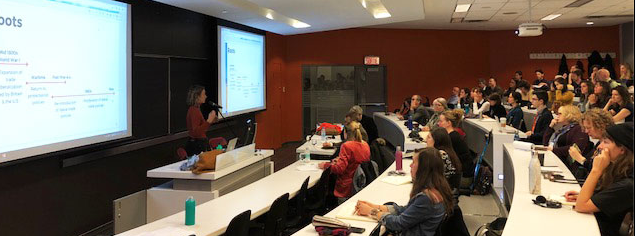Our Changing Food Trade Landscape

by Rhonda Ferguson
How do new technologies affect our food system? How do renegotiated supply management rules impact our food system? And, how do we move past the black/white, good/bad binaries that so often frame debates about trade-related issues? These are just some of the topics that emerged during the presentations and discussion on trade held during Food Secure Canada’s 10th Assembly last month.
Supply Management under the United States–Mexico–Canada Agreement
Recently, the renegotiated trade agreement referred to as USMCA, CUSMA, and sometimes simply, the ‘new NAFTA’ was signed. With the battle over acronyms being just the tip of the iceberg that was fifteen months of difficult negotiations, one of the major sticking points was our supply management system. This is a particularly sensitive issue for Canada’s 220,000 dairy workers, who may face more competition under the agreement.
According to Anouk Collet of the UFCW, 3.6% of our dairy market will be opened up to greater competition through USMCA. However, through CETA, the CPTPP and USMCA combined, 18% could be comprised of imports, having a much larger impact than USMCA alone. While this may not produce negative impacts for consumers’ pocket books, it will open our market to dairy produced according to different standards. Regulations on farm size, animal treatment, and the use of hormones differ greatly between countries. As Sophia Murphy asked in a recent episode of CBC’s Early Edition, “what do we want from our milk? Should it be cheap? [..] How safe should it be? […] What happens to the environment?” In other words, we might consider the social and environmental costs of removing supply management practices, in addition to the economics. For now, many aspects of our supply management system will remain in place, but the slow erosion of this and other regulatory practices threaten our ability to control our food system.
Chilling Effect on Regulatory Autonomy; an Issue of Food Sovereignty
Other national-level food sovereignty issues relate to safety and sanitation rules and limitations on public procurement. Stuart Trew of the Canadian Centre for Policy Alternatives spoke of these  issues and the ‘regulatory chill’ that stems from agreements such as CETA, TPP as well as USMCA, which all seek to strengthen rules on what countries can and cannot do to protect consumers.
issues and the ‘regulatory chill’ that stems from agreements such as CETA, TPP as well as USMCA, which all seek to strengthen rules on what countries can and cannot do to protect consumers.
New agreements shape public procurement practices by placing limits on how governments can prioritize local producers when purchasing food. In CETA, for example, this “extends to municipal governments, hospitals, school boards and universities, where local food procurement can have important community benefits” Trew explained.
Trade and New Technologies
Labour and regulatory issues also arise in the context of trade and new technology. From the automation of food stores to the regulatory challenges of digital trade, Jim Thomas, Co-Executive Director of the ETC Group, got us thinking about how technology is shifting the way we interact with our food system in profound ways. New technologies can subvert the protections that we have in place not only by replacing people in parts of our food systems and changing how cross-border trade happens, but by reclassifying actual food items as digital products through the use of synthetic biology and other developments. He called our attention to USCMA Chapter 19, which encourages barrier-free digital trade and asked us to consider how, if food is digitized, free trade might threaten our control over our food system(s).
Our Food Systems are Interconnected
In the discussion that followed, it was asked how Canada’s food trade policies interact with food insecurity in other parts of the world. We fail to acknowledge how interconnected our food, environmental, and economic issues are, globally, if we don’t seriously consider how our export policies, for example, impact production and consumption elsewhere. There is also insufficient regard for alternative, non-market-based food systems in trade debates. Although USCMA has been hailed as the “most inclusive international trade agreement to date” because of its exceptions for Indigenous peoples’ rights, the impacts of the agreements on Indigenous food sovereignty here and abroad are not adequately addressed.
It’s not all Good or Bad
Supply management, subsidies, harmonization and trade liberalization in general are often discussed as either all ‘bad’ or all ‘good,’ but these narratives do not reflect the complexity of food and agriculture trade, Jill Guerra (UBC graduate) acknowledged. The same rules can impact actors within the food system differently, changing people’s ability to control their food systems - largely without their consent. The secrecy surrounding the negotiation of new deals keeps us in the dark until the rules are in place, which is why knowledge-sharing about their potential impacts is so important.
- Log in to post comments


Comments
web marketing firms
I feel very grateful that I read this. It is very helpful and very informative and I really learned a lot from it.
web marketing firms